You can quickly establish a sense of enhanced privacy for your garden with the right ornamental grass. You don’t need to invest in a new structure to do this. Planting specific tall ornamental grasses provides you with this privacy feature. When wishing to achieve this privacy, fast-growing ornamental grass comes highly recommended for anyone wishing to block out the view of a neighbor’s property in an inexpensive method.
A variety of plants can be used to achieve privacy, such as shrubs and evergreen trees. However, tall ornamental grasses are known to be the most practical option. This is because of the fast-growing rate that these grasses feature. A fantastic feature about these tall ornamental grasses for privacy is that if a part of these specimens die, the gap that becomes present after the specimen’s death is rapidly replaced by a new cultivar’s growth. These plants also have the ability to flourish higher than four feet tall with full sun to part shade.
Criteria for Selection of the Best Tall Ornamental Grasses for Privacy
When selecting ornamental grasses for privacy, you should look for plants that have the following qualities:
- Height: The grasses should be tall enough to create a visual barrier that obscures unwanted views or distractions. Generally, you want grasses that are at least 4 feet tall, but some can grow up to 12 feet or more.
- Hardiness: The grasses should be able to survive the winter temperatures and conditions in your area. Check the USDA hardiness zones of the plants and make sure they match your climate.
- Spread: The grasses should have a moderate to fast growth rate and form dense clumps or colonies that fill in the gaps between plants. Avoid grasses that spread by rhizomes or seeds and become invasive or difficult to control.
- Maintenance: The grasses should be easy to care for and require minimal pruning, watering, fertilizing, or pest control. Most ornamental grasses are low-maintenance plants that only need to be cut back once a year in late winter or early spring.
- Appearance: The grasses should have an attractive appearance that complements your garden style and color scheme. Look for grasses that have interesting foliage colors, textures, shapes, and patterns. Also look for grasses that have showy flowers or seed heads that add interest and contrast.
What are the Best Giant Ornamental Grasses for Full Sun to Part Shade Conditions?
As we have mentioned, this type of grass is a great option if you’re looking for a plant that can grow into an excellent privacy structure. With that being said, there are different variations, which can make choosing a specific plant that you would like to incorporate into your garden quite challenging. For this reason, we have developed a list of the best tall ornamental grasses to help make your decision easier. Here are our top picks:
#1 Pampas Grass (Cortaderia selloana)
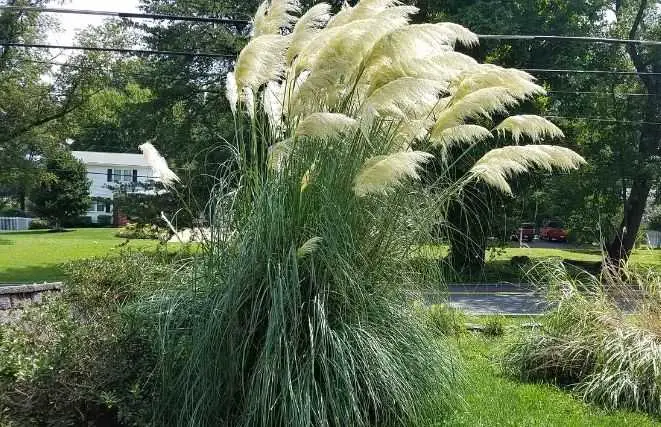
Pampas grass features large clumps of lush-looking foliage and is known as being a great choice if you’re looking for additional privacy in any area. This is known as one of the elegant variations of the native cultivar and offers an easy growing process. This pampas grass is also known to get really massive. Some of these specimens can reach up to 10 feet tall. You need to be careful when it comes to controlling this grass’s spread, as it’s known to grow and spread extremely quickly. Although it works as an excellent privacy feature, it can also take over your garden.
In addition to this, you should make sure that you choose this pampas grass’s tender type. This is known as Cortaderia selloana. When looking at these plants, there are other varieties that you can choose from, but these are more invasive and less attractive. The elements making up these plants ensure that this grass performs in various temperature and light conditions while growing.
However, pampas grass grows best under full sun to part shade conditions. Not to mention, it remains a beautiful structure even in the colder seasons. This pampas grass can tolerate various common problems that affect other plants, such as varied soil conditions, pests, and droughts. For these reasons, it works to create a dramatic backdrop while offering privacy in your garden.
- USDA Growing Zones: 7 to 10
- Sun Exposure: Full sun to partial shade
- Soil Type: Well-drained soil
- Bloom Time: Late summer
- Flower Color: White to pinkish-beige
#2 Feather Reed Grass (Calamagrostis x acutiflora)
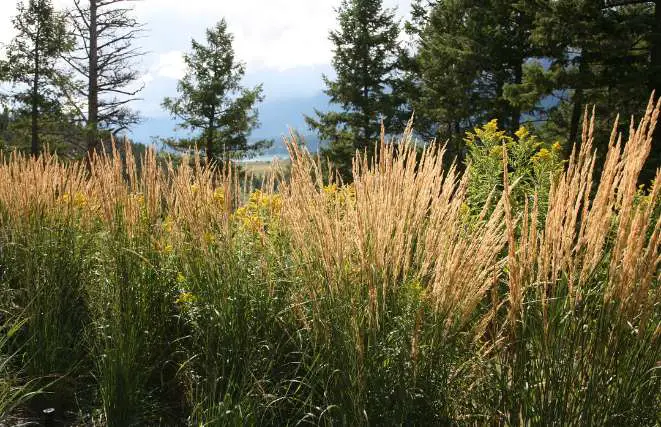
The Feather Reed Grass is one of the most popular types of privacy grass that you can include in your garden. This grass boasts an extremely stylish upright look and offers excellent potential as a privacy structure. One of the best features about this Feather Reed Grass is that you can enjoy it all-year-round. However, this is dependent on the location you’re planting this grass in your garden. Nonetheless, areas with warmer temperature conditions can expect to enjoy this grass in the winter months.
This feather reed grass can also grow in cold-hardy conditions. It can grow up to six feet in height when placed in areas with harsher climates. There are several species that you can consider including in your garden. Some of these species can be softer, while others can be wider or sharper.
Feather Reed Grass generally prefers moisture-retentive soil. However, you shouldn’t encounter any problems if you decide to plant this grass in drier soil. One secret to successfully growing this plant is to nurture it well during the new growth, or initial stages until it grows into a fully established and mature plant in your garden. The plant is known for being sun-loving and can be combined with other perennial plants known to bloom at smaller heights. This can be done to establish a beautiful architectural appearance while providing an effective privacy structure that stands about 4 feet tall.
- USDA Growing Zones: 4 to 9
- Sun Exposure: Full sun to partial shade
- Soil Type: Moist, well-drained soil
- Bloom Time: Summer to fall
- Flower Color: Pinkish-beige
#3 Pink Muhly Grass
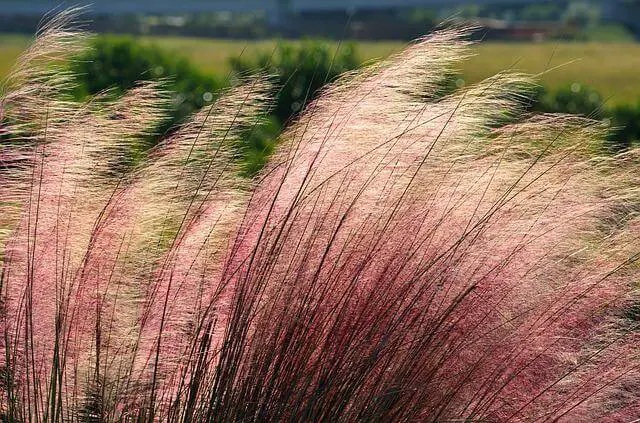
If you want a striking privacy structure, Pink Muhly Grass is the best choice for you. It boasts an appearance that resembles cotton candy that’s floating gracefully in your garden. This is a great grass to use as a privacy measure, as it features dense foliage and vibrant red-pink flowers. The beautiful color included in the plant is retained for reasonably long periods. For a short amount of time, this color transitions into a light tan. Not to mention, this Pink Muhly Grass is also able to keep its beauty throughout the winter season.
- USDA Growing Zones: 6 to 9
- Sun Exposure: Full sun
- Soil Type: Well-drained
- Bloom Time: Late summer to fall
- Flower Color: Pink
#4 Zebra Grass (Miscanthus sinensis ‘Zebrinus’)
It’s no secret that Zebra grass is equipped with a distinctive style that’s fitting to work as an ornament in your yard, as well as a privacy structure to block the view of your neighbor’s property. This added privacy feature is thanks to its thick display of foliage. In addition to this, the grass boasts a rich and elegant gold appearance throughout the summer and spring season. After this, the plant fades not a tan color during the fall and winter.
Not to mention, the plumes included in this Zebra grass have a delightful pink appearance that incorporates great copper hues, which makes the grass stand out in any area you decide to place this plant in your yard. This perennial Zebra grass is known to reach seven feet tall while being six feet thick. With that being said, this Zebra grass needs a decent-sized area in order to spread its roots.
There aren’t strict growth requirements for this Zebra grass. This plant thrives when placed in areas that receive full sun. The soil used should also be well-drained. One amazing feature about this zebra grass is that you don’t need to worry about the soil’s fertility. This is because the grass is equipped to handle a vast range of soil types. Anyone can plant this grass, as it’s usually not affected by pests or diseases easily. It also boasts incredible versatility, which means that it can be planted as hedges or screens to accent your garden or enhance the privacy of your home.
- USDA Growing Zones: 5 to 9
- Sun Exposure: Full sun to part shade
- Soil Type: Well-drained
- Bloom Time: Late summer to fall
- Flower Color: Tan to brown
#5 Fountain Grass (Pennisetum alopecuroides)
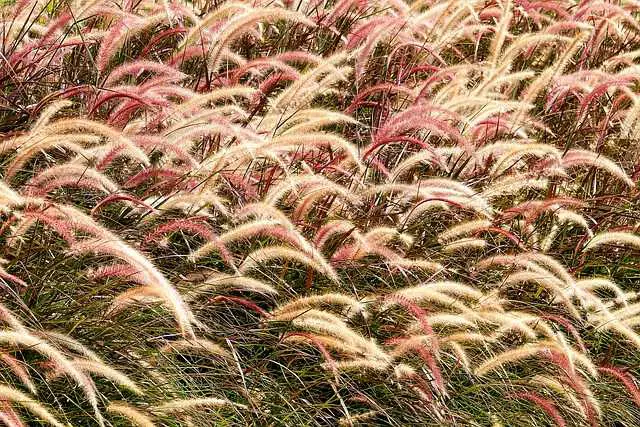
Fountain grass is native to Eastern Asia and Japan and offers a graceful look with its cascading foliage that’s known to sway effortlessly in the wind. It comes with a basic maintenance procedure while offering a stunning appearance. There are also dwarf cultivars of fountain grass available, which is why you make sure that you’re purchasing the right plant that grows at less than seven feet tall if you want it to serve as a privacy screen. Some only reach as tall as 4 feet. This fountain grass is also seen as a great option if you’re looking to decorate beds and borders. This is due to its textural feel of the plant. It also flourishes during spring.
- USDA Growing Zones: 5 to 9
- Sun Exposure: Full sun to part shade
- Soil Type: Well-drained
- Bloom Time: Late summer to fall
- Flower Color: Creamy-white, pink, or purple
#6 Big Bluestem (Andropogon gerardii)
Big Bluestem Grass is known to reach up to eight feet tall. This makes it excellent for privacy planting. However, it doesn’t have a beautiful appearance. It looks similar to a turkey’s foot because of the seeded branches breaking into three different parts. One of the best features about this Big Bluestem grass is that it’s well-adapted to drought while having the ability to handle a variety of different soils. All that you need to plan for is that this Big Bluestem plant receives enough sunlight. Thus, placing the Big Bluestem in an area with full sun to part shade would be beneficial. This plant is also non-toxic, which makes it a great addition to any yard.
- USDA Growing Zones: 4 to 9
- Sun Exposure: Full sun
- Soil Type: Well-drained, sandy or loamy
- Bloom Time: Late summer to fall
- Flower Color: Blue-green
#7 Switchgrass (Panicum virgatum)
Switchgrass can reach up to eight feet tall, which allows it to form a clump of blue-colored foliage. In addition to this, it also boasts a golden appearance in the summer. This is due to the flower panicles that are nicely-textured. This color only intensifies until it eventually reaches a striking dark golden look in fall. This switchgrass is also known to have a long lifespan and is a North American prairie grass that works well in moist soil. It also works as an excellent privacy structure, as it can reach up to a little over eight feet.
There are multiple specimens of switchgrass that have appearances that look more impressive and elegant. In addition to being excellent for privacy, it also works well if you want to enhance your garden’s overall appearance. This is because it works to add nice texture and colors to the borders of your yard. Not to mention, this switchgrass plant performs incredibly well under full sun to part shade environments and can be placed in a little drier or moist soil. There aren’t any severe disease or pest issues to fear when caring for this plant. The majority of scientists believe this switchgrass to be incredibly robust and sturdy when it comes to growing in drought periods. This plant is known to handle the winter period with elegance and while providing a variety of benefits, such as protection for birds. This is with one exception, which is very snowy areas.
- USDA Growing Zones: 5 to 9
- Sun Exposure: Full sun to part shade
- Soil Type: Well-drained soil
- Bloom Time: Late summer
- Flower Color: Pink to reddish-brown
#8 Fargesia Robusta Bamboo
A massive misconception is that bamboo is a tree. This isn’t true, as it’s actually one variety of grass. There are multiple varieties, such as Fargesia Robusta Bamboo, which can successfully be used as a privacy screen for your yard. In addition to this added privacy feature, it also offers an exceptional appearance that can enhance your garden’s overall look.
With that being said, it’s crucial to purchase Fargesia clumping bamboo varieties. This is because other bamboo types are generally too invasive and can be a problem when it comes to controlling the plant. In addition to this, Fargesia Robusta is known as an exemplary bamboo type, which works to create a stunning dual-color display. The beauty behind using Fargesia Robusta bamboo is that it’s straightforward to grow without much input from the gardener. Not to mention, it reaches impressive heights and there are a variety of bamboo options that can stand up to 15 feet.
Unlike the other options on this list, the plant doesn’t require full sun to part shade. In fact, it can work incredibly well even when it’s placed in very shady areas. Thus, you aren’t restricted to areas in your yard. This means that you can gain a privacy structure wherever you would like in your yard without having to worry about the sun being a factor. All of these features make this bamboo and an excellent choice if you’re looking for a privacy feature.
- USDA Growing Zones: 7 to 9
- Sun Exposure: Full Sun, Part Shade, Shade
- Soil Type: Moist but Well-drained soil
- Flower Color: Light Green
#9 Miscanthus (Miscanthus sinensis)
Miscanthus is a large genus of perennial grasses that can grow up to 12 feet tall and 6 feet wide. It has arching green leaves with white midribs and silver stripes that turn reddish-brown in fall. It also has showy flower plumes that appear in late summer or fall and persist into winter. The flowers range in color from pink to red to silver.
Miscanthus is hardy in zones 5 to 9 and prefers full sun and well-drained soil. It is not invasive but may self-seed in some areas. It is drought-tolerant and deer-resistant.
Miscanthus is a great option for creating privacy along property lines, driveways, or roadsides. It can also be used as a focal point or in mixed borders. It offers four seasons of interest and attracts birds and butterflies.
There are many cultivars of miscanthus available with different heights, colors, textures, and shapes. Some of the best ones for privacy are ‘Gracillimus’, ‘Morning Light’, ‘Silberfeder’, ‘Giganteus’, and ‘Adagio’.
- USDA Growing Zones: 5 to 9
- Sun Exposure: Full sun to partial shade
- Soil Type: Well-drained soil
- Bloom Time: Late summer
- Flower Color: Silver to pinkish-red
#10 Giant Silver Grass (Miscanthus giganteus)
Giant silver grass is a hybrid of miscanthus that grows up to 12 feet tall and 6 feet wide. It has broad green leaves with white midribs that turn yellow in fall. It also has large flower plumes that appear in late summer or fall and last until winter. The flowers are silvery-pink and fade to tan.
Giant silver grass is hardy in zones 5 to 9 and prefers full sun and moist, well-drained soil. It is not invasive but may self-seed in some areas. It is drought-tolerant and deer-resistant.
Giant silver grass is a great option for creating privacy along property lines, driveways, or roadsides. It can also be used as a focal point or in large groups. It offers a dramatic presence and attracts birds.
Giant silver grass is also a valuable plant for biofuel production because of its high biomass yield.
- USDA Growing Zones: 6 to 9
- Sun Exposure: Full sun
- Soil Type: Well-drained
- Bloom Time: Late summer to fall
- Flower Color: Silvery-white
#11 Ravenna Grass (Saccharum ravennae)
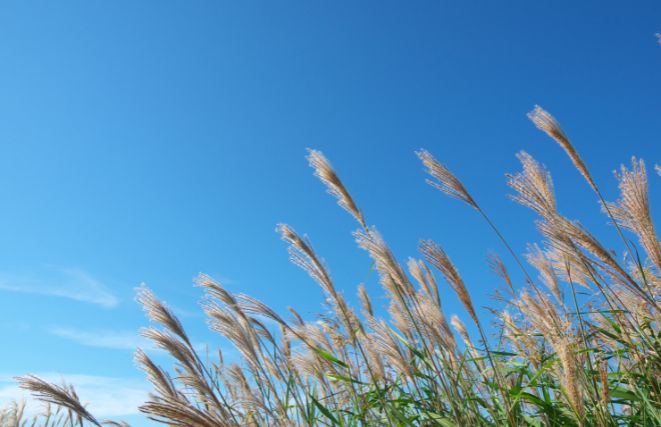
Ravenna grass (Erianthus ravennae) is a perennial grass that grows up to 12 feet tall and 4 feet wide. It has gray-green leaves that turn yellow in fall and winter. It also has large flower plumes that appear in late summer or fall and last until winter. The flowers are silvery-white and fluffy.
Ravenna grass is hardy in zones 5 to 9 and prefers full sun and moist, well-drained soil. It is not invasive but may self-seed in some areas. It is drought-tolerant and deer-resistant.
Ravenna grass is a great option for creating privacy along property lines, driveways, or roadsides. It can also be used as a focal point or in large groups. It offers a dramatic presence and attracts birds.
Ravenna grass is also known as plume grass or hardy pampas grass because of its resemblance to pampas grass.
- USDA Growing Zones: 6 to 9
- Sun Exposure: Full sun
- Soil Type: Well-drained
- Bloom Time: Late summer to fall
- Flower Color: Silvery-white
#12 Northern Sea Oats (Chasmanthium latifolium)
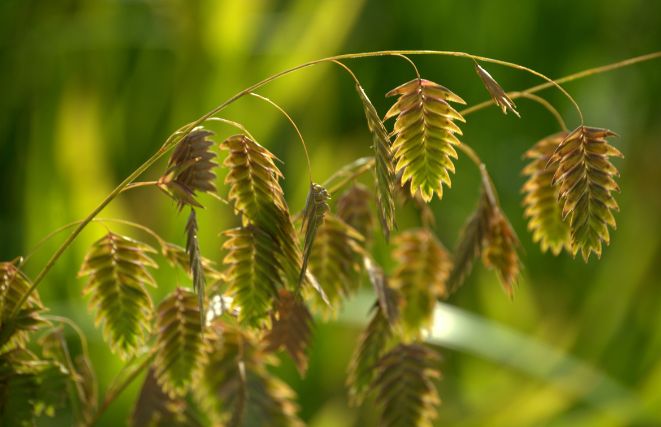
Northern sea oats is a native perennial grass that grows up to 4 feet tall and wide. It has bright green leaves that turn yellow in fall and winter. It also has distinctive flower spikes that hang from thin stems and appear in late summer or fall. The flowers are flat, oat-like seeds that can be green, bronze, or copper.
Northern sea oats is hardy in zones 3 to 8 and prefers partial shade and moist, well-drained soil. It can tolerate full sun if kept moist. It is not invasive but may self-seed in some areas.
Northern sea oats is a good choice for creating privacy along shady areas, such as woodlands or streams. It can also be used as an accent plant or in containers. It provides year-round interest and attracts birds.
Northern sea oats is also known as inland sea oats or river oats because of its habitat preference.
- USDA Growing Zones: 5 to 9
- Sun Exposure: Part shade to full sun
- Soil Type: Moist, well-drained
- Bloom Time: Late summer
- Flower Color: Bronze to brown
Fastest growing privacy grass
When it comes to fast-growing grasses that provide privacy, there are a few options to consider:
- Bamboo: Bamboo is known for its rapid growth and dense foliage, making it an excellent choice for creating privacy screens. Certain bamboo varieties can grow several feet in a single season, providing quick coverage.
- Leyland Cypress: Although not a grass, Leyland Cypress is a popular choice for creating fast-growing privacy hedges. It can grow up to 3 feet per year and reaches a mature height of around 50 feet, forming a thick barrier.
- Fountain Grass (Pennisetum): While not specifically grown for privacy, some varieties of Fountain Grass can grow quite quickly, reaching heights of 3 to 4 feet in a single season. They can be used as part of a larger planting to provide some privacy.
It’s worth noting that the growth rate can vary based on factors such as climate, soil conditions, and proper care. When selecting a privacy grass, consider your specific requirements, maintenance needs, and the suitability of the grass for your region’s climate and growing conditions.
Tallest ornamental grasses
When it comes to tall ornamental grasses, several varieties stand out for their impressive height:
- Miscanthus giganteus: Also known as Giant Miscanthus, this grass can reach towering heights of 10 to 12 feet or even more. It has thick, upright stalks and large, feathery plumes that add drama and visual impact to landscapes.
- Cortaderia selloana: Commonly known as Pampas Grass, this ornamental grass can grow up to 8 to 12 feet in height. It features large, fluffy plumes that create a stunning focal point in gardens and provide a sense of privacy.
- Calamagrostis x acutiflora ‘Karl Foerster’: This feather reed grass cultivar is known for its tall, narrow growth habit. It typically reaches heights of 4 to 6 feet, and its upright stems and feathery plumes add vertical interest to garden designs.
- Saccharum ravennae: Also called Ravenna Grass, this grass can grow to heights of 8 to 12 feet. It features large, arching plumes and can create a striking visual impact when used in borders or as a standalone specimen.
- Andropogon gerardii: Commonly known as Big Bluestem or Turkeyfoot, this native prairie grass can reach heights of 5 to 8 feet. It has attractive blue-green foliage and develops distinctive seed heads that add texture and beauty to landscapes.
These tall ornamental grasses provide architectural interest, vertical accents, and a sense of privacy when used strategically in landscaping projects.
Tall grasses for privacy zone 5
For privacy in Zone 5, where winters can be cold, you can consider the following tall grasses that thrive in this climate:
- Switchgrass (Panicum virgatum): Switchgrass is a native grass that grows well in Zone 5. It can reach heights of 4 to 6 feet, providing excellent privacy screening. Varieties like ‘Shenandoah’ and ‘Cloud Nine’ offer attractive foliage colors and plumes.
- Big Bluestem (Andropogon gerardii): Another native grass, Big Bluestem, is well-suited to Zone 5. It can grow 4 to 6 feet tall and forms clumps of attractive blue-green foliage. It provides both privacy and visual interest in the landscape.
- Feather Reed Grass (Calamagrostis x acutiflora): Certain cultivars of Feather Reed Grass, such as ‘Karl Foerster,’ are hardy in Zone 5. They can reach heights of 4 to 6 feet, offering privacy and elegant vertical accents with their upright growth habit.
- Little Bluestem (Schizachyrium scoparium): Little Bluestem is a shorter grass compared to others on this list, typically reaching 2 to 4 feet in height. However, it forms dense clumps and provides some privacy while adding beauty with its reddish-brown foliage in fall.
These grasses are well-suited for Zone 5 conditions and offer both privacy and aesthetic value in your landscape. Remember to consider factors like sunlight, soil conditions, and maintenance requirements when selecting and planting tall grasses for privacy.
How to Use Tall Ornamental Grasses for Privacy
There are many ways to use tall ornamental grasses for privacy in your garden. Here are some ideas:
Create a hedge
You can plant tall ornamental grasses along your fence line, wall, or property boundary to create a natural hedge that blocks unwanted views and adds beauty and texture to your landscape. You can choose one type of grass or mix different varieties for more interest and diversity. Make sure you leave enough space between each plant to allow for air circulation and growth. You can also prune or trim your hedge to keep it neat and tidy.
Create a screen
You can plant tall ornamental grasses behind or around a feature or area that you want to screen or hide, such as a patio, a pool, a shed, a compost bin, or an air conditioner unit. You can use one type of grass or mix different varieties for more interest and diversity. Make sure you leave enough space between each plant to allow for air circulation and growth. You can also prune or trim your screen to keep it neat and tidy.
Create an accent
You can utilize tall ornamental grasses in your garden as standalone plants, focal points, or decorative additions. Their primary function is to draw attention to specific areas, introduce verticality and a sense of drama, or offer a contrasting element amidst the surrounding vegetation. You have the option to select a single species of grass or combine different types to enhance visual appeal and introduce greater diversity. It is essential to allocate sufficient space around each plant to ensure proper airflow, access to light, and prevent overcrowding by neighboring plants.
Create a backdrop
To establish a captivating backdrop for your garden border, consider incorporating tall ornamental grasses towards the rear. These grasses serve the purpose of introducing a visually striking element that complements your other plants. They contribute to the overall garden design by providing verticality, vibrant colors, intriguing textures, and graceful movement. You have the flexibility to opt for a single grass species or combine various varieties to enhance both interest and diversity. It is essential to ensure ample space is provided around each plant to facilitate proper air circulation, access to light, and prevent overcrowding caused by neighboring plants.
Create a focal point
In your garden, you have the option to incorporate tall ornamental grasses as prominent elements, capturing focus on particular areas or distinctive features. These grasses serve to introduce a sense of drama, contrast, or even harmony when combined with your existing plants. You have the flexibility to select a single grass species or blend different varieties to enhance visual appeal and introduce a range of characteristics. It is vital to allocate adequate space around each plant to facilitate proper airflow, access to light, and prevent overcrowding by neighboring plants.
How to Grow and Care for Tall Ornamental Grasses for Privacy
Tall ornamental grasses for privacy are generally easy to grow and care for, but they do require some basic maintenance to keep them healthy and attractive. Here are some tips on how to grow and care for tall ornamental grasses:
Planting
The best time to plant tall ornamental grasses is in spring or early fall, when the soil is moist and easy to work with. Choose a site that receives full sun or part shade and has well-drained soil. Dig a hole that is twice as wide and as deep as the root ball of your grass. Loosen the roots gently and place the plant in the hole, making sure the crown (where the roots meet the stems) is level with the soil surface. Fill the hole with soil and water well. Space your plants according to their mature size and spread.
Watering
Tall ornamental grasses are drought-tolerant once established, but they need regular watering during their first year of growth to help them develop strong roots. Water your plants deeply and thoroughly once a week or more often during hot or dry periods. Avoid overwatering or letting the soil become soggy, as this can cause root rot or fungal diseases.
Fertilizing
Tall ornamental grasses do not need much fertilizer, as this can make them grow too fast and become weak or floppy. You can apply a balanced organic fertilizer once a year in spring or fall, following the package directions. Avoid high-nitrogen fertilizers, as this can promote leafy growth at the expense of flowers.
Pruning
Tall ornamental grasses do not need much pruning, except for removing dead or damaged stems or leaves. You can also cut back your plants in late winter or early spring before new growth emerges, leaving about 6 inches of stubble above the ground. This will help your plants look neater and encourage fresh growth. Do not cut back your plants in fall or winter, as this can expose them to cold damage or disease.
Dividing
Tall ornamental grasses tend to form large clumps over time, which can become overcrowded or lose their vigor. You can divide your plants every three to five years in spring or fall to rejuvenate them and propagate new plants. To divide your plants, dig up the entire clump with a spade or fork and cut it into smaller sections with a sharp knife or saw. Discard any dead or diseased parts and replant the healthy sections in new locations.
Pests and diseases
Tall ornamental grasses are generally resistant to pests and diseases, but they may occasionally suffer from aphids, spider mites, rust, powdery mildew, or leaf spots. To prevent these problems, keep your plants healthy by providing adequate water, light, air circulation, and drainage. You can also spray your plants with insecticidal soap or neem oil to control insects or fungal infections.
Why Should You Use Tall Ornamental Grass for Privacy?
This type of grass is widely known for its rapid growth potential. Thus, you’re able to maintain the privacy structure that you set up using this grass. It also works best in full sun to part shade conditions, which means that you have the choice of planting it everywhere you wish. Not to mention, it also works as a very versatile cultivar that can grow in many different temperatures. Its height is very tall, as some can grow as tall as 10 to 12 feet. In addition to this, it also grows wide. Therefore, you’re able to gain a broad and tall privacy structure when growing this grass. All of these features make it an exceptional choice if you’re looking for added privacy in your garden.
How tall is tall grass?
The term “tall grass” can vary depending on the context and the specific type of grass being referred to. In general, tall grasses can range in height from a few feet to several feet or even taller. Some varieties of ornamental grasses, such as Miscanthus or pampas grass, can grow to heights of 6 to 12 feet or more. Native prairie grasses like Big Bluestem or Switchgrass can also reach impressive heights, typically ranging from 4 to 8 feet. However, it’s important to note that the height of grasses can be influenced by various factors, including growing conditions, climate, and specific cultivars.
What is tallest ornamental grass for privacy?
The Miscanthus giganteus, commonly known as Giant Miscanthus, is considered one of the tallest ornamental grasses for privacy. It can reach impressive heights of 10 to 12 feet or even more. With its dense growth and towering plumes, Giant Miscanthus provides excellent privacy screening, making it a popular choice for creating natural barriers in landscapes and gardens.
People Also Ask
You might be wondering what ornamental grass is. Many gardeners consider these plants as being anything where you get narrow and long foliage. In addition to this, it’s expected that these plants grow in the same way. However, some of the best and most common ‘grass’ structures are actually grass-like perennials.
Genuine ornamental grasses are equipped to include genera within the four main variants. These are sedges, plants, reeds, and rushes. All of these variants have entirely different requirements while spreading in varied ways. Ornamental-type plants are hybrids of grass-like perennials and work well in providing privacy and block views to any garden.
There are several types of ornamental grasses that can grow quite tall, but one of the tallest is the miscanthus (Miscanthus spp.). This grass can grow up to 12 feet (3.7 meters) tall in some varieties, although most cultivars typically reach heights between 5 and 8 feet (1.5 to 2.4 meters).
Other ornamental grasses that can grow tall include giant reed (Arundo donax), pampas grass (Cortaderia selloana), and ravenna grass (Erianthus ravennae), which can all reach heights of 6 to 10 feet (1.8 to 3 meters) or more in some cases.
It’s important to note that the height of ornamental grasses can vary depending on the growing conditions and cultivar, so it’s always a good idea to research specific varieties and consult with a knowledgeable plant expert to find the best option for your particular needs and growing conditions.
Conclusion
Evergreen ornamental grasses
Tall Ornamental grasses are beautiful and durable plants that can be used in many different landscapes. However, there are many different types of tall ornamental grasses.
Evergreen ornamental grasses also require less maintenance than other varieties because they don’t need to be pruned or trimmed very often. When they do need to be trimmed, however, it’s usually a quick and easy process because the blades of the shears simply glide through these stalks easily without getting caught on any spiky or sharp edges.
Privacy grass
There are many potential solutions that have been proposed by various experts. One of the most promising is a type of pampas grass that can grow taller than people and block line of sight to those on the other side.
Some plants, such as bamboo and ivy, can grow as high as 20 feet in some cases and provide some degree of privacy if they are not trimmed back. Plus, these plants do not require any type of upkeep which makes them attractive options for those looking for a more eco-friendly solution to keeping their space private.








